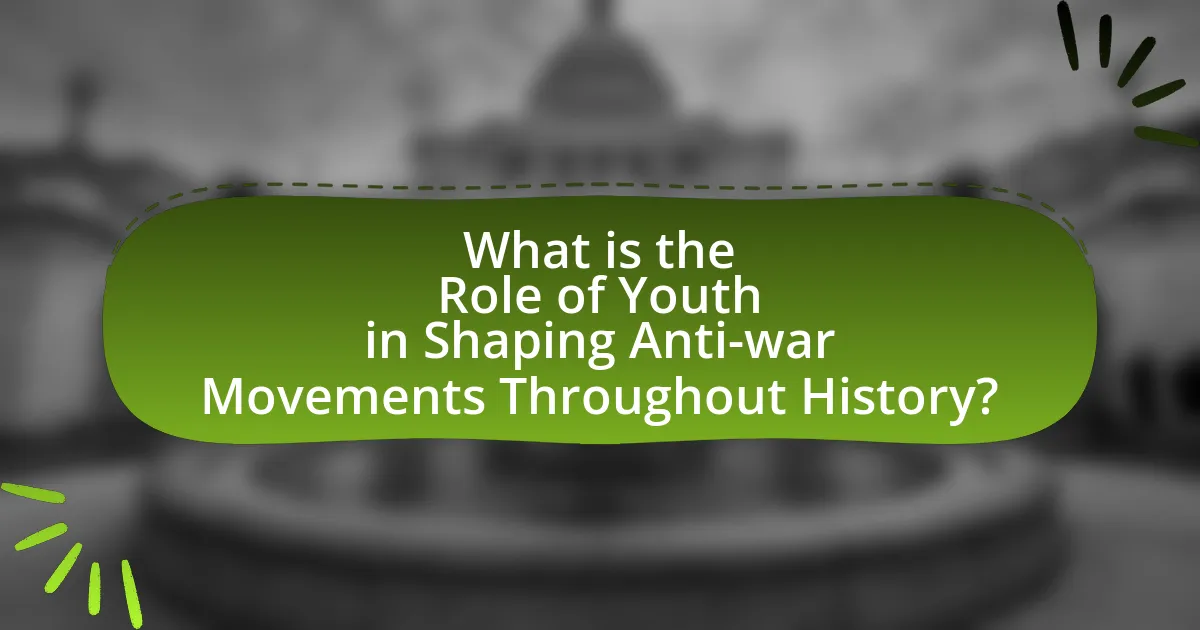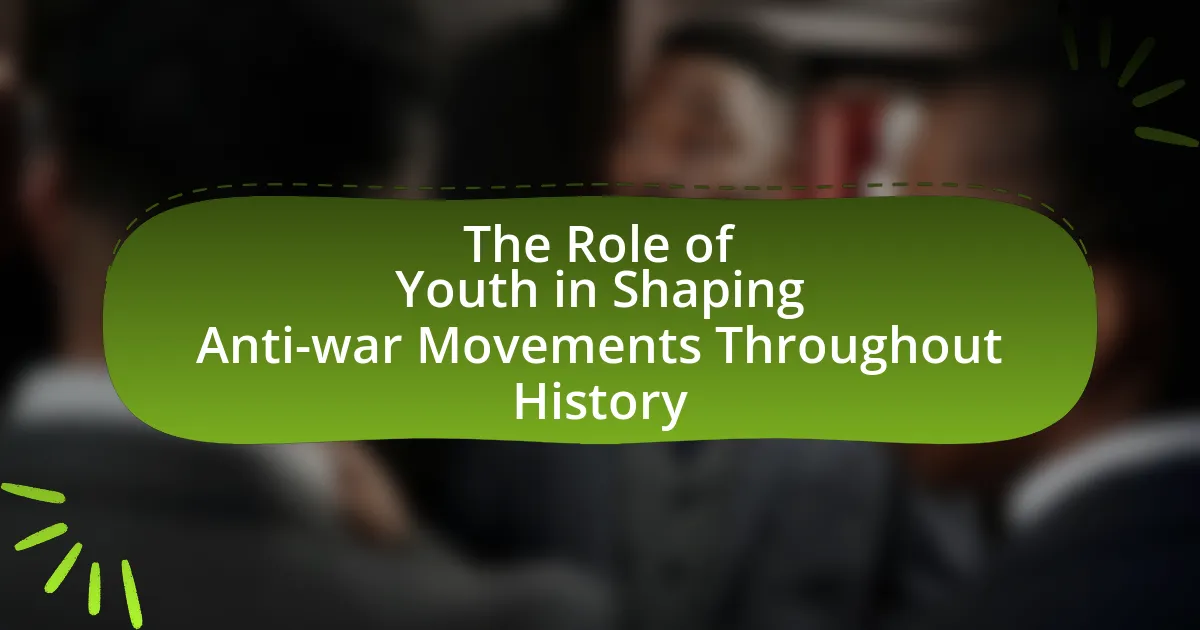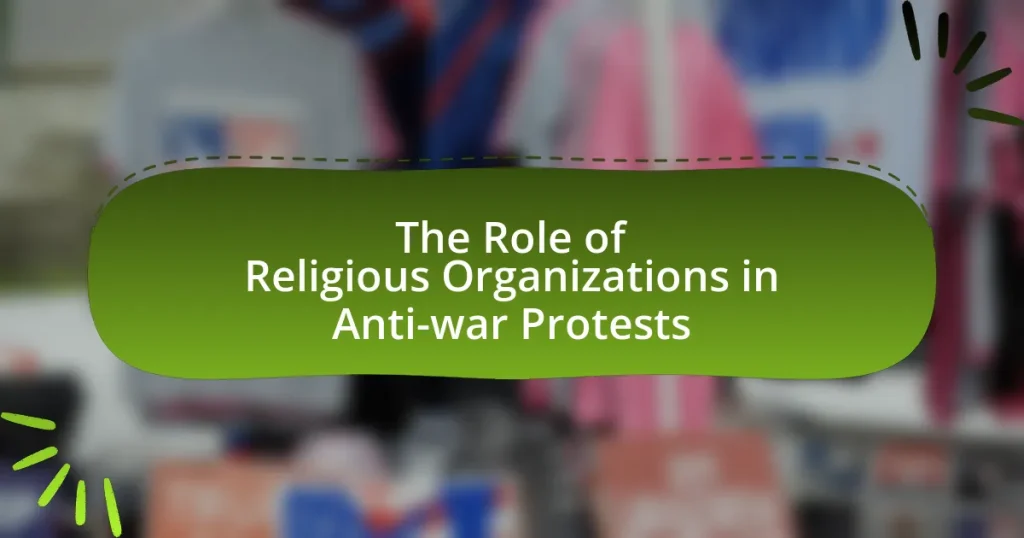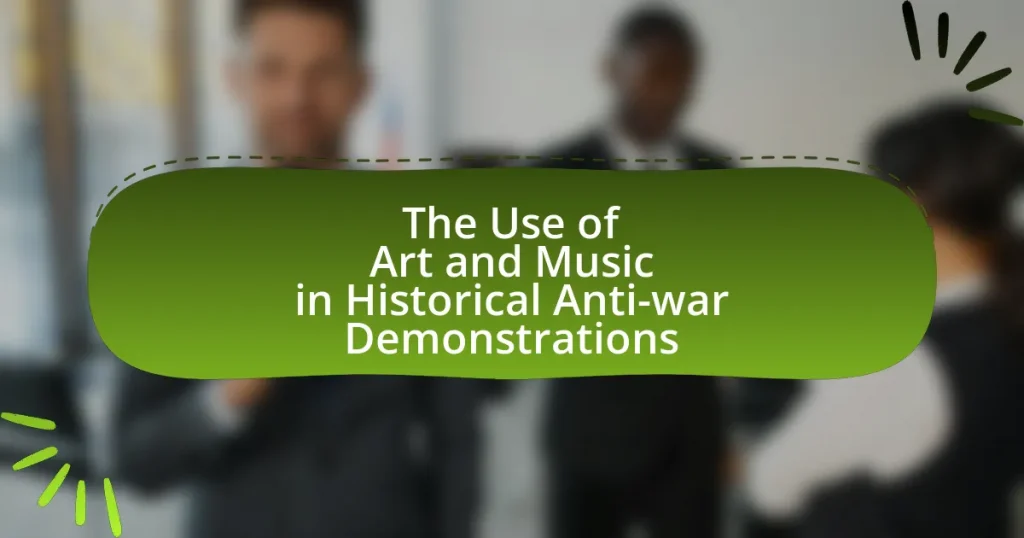The article examines the significant role of youth in shaping anti-war movements throughout history, highlighting their contributions to mobilizing public opinion, organizing protests, and advocating for peace. It discusses key historical contexts, such as the Vietnam War and contemporary movements like March for Our Lives, illustrating how youth activism has influenced public policy and societal attitudes towards war. The article also addresses the challenges faced by young activists, the impact of social media, and the importance of collaboration with other social justice movements, providing insights into the evolution and future of youth-led anti-war efforts.

What is the Role of Youth in Shaping Anti-war Movements Throughout History?
Youth have played a crucial role in shaping anti-war movements throughout history by mobilizing public opinion, organizing protests, and advocating for peace. For instance, during the Vietnam War, young activists, particularly college students, led significant demonstrations, such as the 1969 Moratorium to End the War in Vietnam, which drew millions of participants and highlighted widespread opposition to the conflict. Additionally, youth-led organizations like Students for a Democratic Society (SDS) were instrumental in articulating anti-war sentiments and fostering a culture of dissent. Historical evidence shows that youth engagement in these movements often catalyzed broader societal shifts, influencing policy changes and public discourse regarding war and peace.
How have youth contributed to anti-war movements in different historical contexts?
Youth have significantly contributed to anti-war movements across various historical contexts by mobilizing public opinion, organizing protests, and advocating for peace. For instance, during the Vietnam War, American youth played a crucial role in the anti-war movement, exemplified by the 1969 Moratorium to End the War in Vietnam, which drew millions of participants and highlighted the widespread opposition to the conflict. Similarly, in the 1980s, young activists in Europe protested against nuclear weapons, leading to the formation of groups like the Campaign for Nuclear Disarmament in the UK, which galvanized public support and influenced policy discussions. In more recent times, youth-led movements such as the March for Our Lives have connected gun violence and militarism, demonstrating a continued commitment to anti-war advocacy. These examples illustrate how youth have historically been at the forefront of anti-war efforts, shaping discourse and driving change through collective action.
What specific events highlight youth involvement in anti-war movements?
Specific events that highlight youth involvement in anti-war movements include the Kent State shootings in 1970, where four students were killed during a protest against the Vietnam War, galvanizing national outrage and activism among young people. Another significant event is the 1969 Woodstock Festival, which became a symbol of the counterculture movement and featured anti-war sentiments, attracting a large youth audience. Additionally, the March on Washington for Jobs and Freedom in 1963, while primarily focused on civil rights, also included strong anti-war messages, showcasing youth participation in broader social justice issues. These events collectively demonstrate the critical role of youth in shaping anti-war movements throughout history.
How did youth activism evolve during major wars?
Youth activism evolved significantly during major wars, transitioning from passive support to active opposition against war policies. For instance, during World War I, youth initially rallied for nationalistic causes but later formed organizations like the American Youth Congress, advocating for peace and social reform. In World War II, young people participated in anti-war movements, exemplified by the founding of the Student Nonviolent Coordinating Committee in the 1960s, which protested against the Vietnam War. This shift was marked by increased political awareness and mobilization, as youth leveraged media and grassroots organizing to challenge government narratives. The evolution of youth activism during these conflicts illustrates a growing recognition of the power of young voices in shaping public discourse and policy regarding war.
Why is youth participation significant in anti-war movements?
Youth participation is significant in anti-war movements because young people often drive social change and bring fresh perspectives to activism. Historically, youth have been at the forefront of major anti-war protests, such as the Vietnam War demonstrations in the 1960s, where students mobilized on campuses across the United States, influencing public opinion and policy. Their involvement is crucial as they represent a demographic that will be most affected by the consequences of war, thus amplifying their voices in advocating for peace. Additionally, youth are adept at utilizing modern communication tools, enabling them to organize effectively and reach wider audiences, as seen in movements like the March for Our Lives. This combination of passion, urgency, and innovative outreach makes youth participation a vital component of anti-war efforts.
What unique perspectives do young people bring to anti-war activism?
Young people bring fresh, innovative perspectives to anti-war activism by leveraging technology and social media to mobilize and engage a broader audience. Their adeptness with digital platforms allows them to disseminate information rapidly, organize protests, and create viral campaigns that resonate with their peers. For instance, the global youth-led climate strikes demonstrate how young activists can effectively connect issues of war, environmental degradation, and social justice, highlighting the interconnectedness of these challenges. Additionally, young activists often challenge traditional narratives and authority, advocating for peace through inclusive dialogue and grassroots movements, as seen in the rise of organizations like Students for a Democratic Society during the Vietnam War era. This generational shift in approach emphasizes creativity, collaboration, and a commitment to systemic change, making their contributions vital to the evolution of anti-war movements.
How does youth engagement influence public opinion on war?
Youth engagement significantly influences public opinion on war by mobilizing activism and shaping narratives through social media and grassroots movements. For instance, during the Vietnam War, youth-led protests, such as those organized by Students for a Democratic Society, played a crucial role in shifting public sentiment against the war, leading to increased skepticism and opposition among the general population. Additionally, contemporary movements like the March for Our Lives demonstrate how young activists can effectively use platforms like Twitter and Instagram to raise awareness and galvanize support, thereby altering perceptions of military conflict. This historical and ongoing trend illustrates that when youth actively participate in discussions and actions regarding war, they can effectively sway public opinion and policy decisions.
What challenges do youth face in anti-war movements?
Youth face several challenges in anti-war movements, including societal apathy, lack of resources, and governmental repression. Societal apathy often manifests as indifference from older generations, which can undermine youth efforts and diminish their impact. Additionally, limited access to funding and organizational support restricts youth from mobilizing effectively, as many anti-war initiatives require financial backing for events and campaigns. Governmental repression, such as surveillance and legal repercussions for protests, poses a significant threat to youth activists, discouraging participation and limiting their ability to express dissent. Historical examples, such as the Vietnam War protests, illustrate how youth movements were often met with hostility and repression, highlighting the persistent challenges they face in advocating for peace.
How do societal perceptions impact youth activism against war?
Societal perceptions significantly influence youth activism against war by shaping the narratives and values that young activists adopt. When society views war negatively, it encourages youth to mobilize and advocate for peace, as seen during the Vietnam War era when widespread anti-war sentiment galvanized young people to protest. Conversely, if society perceives war as justified or necessary, youth activism may be stifled, as demonstrated in contexts where patriotic sentiments dominate public discourse. Research indicates that youth are more likely to engage in activism when they feel supported by their communities, highlighting the importance of societal attitudes in fostering or hindering their efforts against war.
What barriers do young activists encounter in their efforts?
Young activists encounter several barriers in their efforts, including lack of funding, limited access to decision-making platforms, and societal pushback. These obstacles hinder their ability to mobilize effectively and influence policy. For instance, a study by the United Nations found that youth-led initiatives often struggle to secure financial resources, which are crucial for organizing events and campaigns. Additionally, young activists frequently face resistance from established political structures that may dismiss their contributions due to their age. This combination of financial constraints and institutional barriers significantly impedes their activism and engagement in anti-war movements.
How can youth effectively mobilize for anti-war causes?
Youth can effectively mobilize for anti-war causes by leveraging social media platforms to raise awareness and organize events. Social media enables rapid dissemination of information, allowing young activists to connect with like-minded individuals and coordinate protests or campaigns. For instance, the 2019 climate strikes, which saw millions of young people participating globally, demonstrated the power of social media in mobilizing youth around a common cause. Additionally, youth can engage in grassroots organizing by forming local groups that focus on education and advocacy, thereby fostering community involvement and support. Historical examples, such as the Vietnam War protests in the 1960s, illustrate how youth-led movements can influence public opinion and policy through sustained activism and coalition-building.
What strategies have proven successful for youth-led anti-war movements?
Youth-led anti-war movements have successfully utilized grassroots organizing, digital activism, and coalition-building as key strategies. Grassroots organizing allows young activists to mobilize their communities, exemplified by the Vietnam War protests where students organized sit-ins and marches, significantly influencing public opinion. Digital activism leverages social media platforms to spread awareness and engage a broader audience, as seen in the recent climate justice movements that intersect with anti-war sentiments. Coalition-building with established organizations enhances their reach and impact, demonstrated by youth alliances with groups like Veterans for Peace, which amplify their voices and demands. These strategies collectively empower youth to challenge war narratives and advocate for peace effectively.
How do social media and technology enhance youth activism?
Social media and technology enhance youth activism by providing platforms for rapid communication, organization, and mobilization. These tools allow young activists to share information instantly, coordinate events, and amplify their messages to a global audience. For instance, the use of Twitter during the Arab Spring enabled youth to organize protests and disseminate real-time updates, significantly impacting the movement’s visibility and effectiveness. Additionally, platforms like Instagram and TikTok have become vital for creative expression and storytelling, allowing youth to engage their peers emotionally and raise awareness about social issues. The Pew Research Center reported that 72% of teens use social media, highlighting its role as a primary means of communication and activism among young people today.
What role do educational institutions play in fostering anti-war sentiments among youth?
Educational institutions play a crucial role in fostering anti-war sentiments among youth by providing a platform for critical thinking, discussion, and activism. Schools and universities often incorporate peace studies, history, and social justice curricula that encourage students to analyze the consequences of war and the importance of diplomacy. For instance, programs like Model United Nations and student-led peace clubs empower youth to engage in dialogue about conflict resolution and global issues. Research indicates that exposure to diverse perspectives in educational settings can significantly influence students’ attitudes towards war, as seen in studies conducted by the American Psychological Association, which highlight the correlation between education and increased advocacy for peace.

What historical examples illustrate the impact of youth in anti-war movements?
Youth have significantly influenced anti-war movements throughout history, with notable examples including the Vietnam War protests in the 1960s and the more recent March for Our Lives movement against gun violence. During the Vietnam War, students organized mass protests, such as the 1969 Moratorium to End the War in Vietnam, which drew millions of participants and highlighted the widespread opposition to U.S. involvement in the conflict. This mobilization of youth played a crucial role in shifting public opinion and pressuring policymakers. Similarly, the March for Our Lives movement, initiated by students from Stoneman Douglas High School after the 2018 shooting, galvanized young people across the United States to advocate for gun control, demonstrating the power of youth activism in shaping contemporary social issues. These examples illustrate how youth engagement has historically been pivotal in driving anti-war sentiments and influencing societal change.
How did the Vietnam War catalyze youth activism?
The Vietnam War catalyzed youth activism by mobilizing young people across the United States to protest against the war and advocate for peace. This mobilization was driven by the draft, which disproportionately affected college students and young men, leading to widespread opposition to U.S. involvement in Vietnam. The establishment of organizations like Students for a Democratic Society (SDS) and the use of media to disseminate anti-war messages further galvanized youth participation. By 1969, over 250,000 students participated in protests, demonstrating the significant role youth played in shaping the anti-war movement and influencing public opinion against the war.
What were the key organizations formed by youth during the Vietnam War?
The key organizations formed by youth during the Vietnam War included Students for a Democratic Society (SDS), the Youth International Party (Yippies), and the Vietnam Veterans Against the War (VVAW). SDS, founded in 1960, played a significant role in mobilizing college students against the war, advocating for civil rights and social justice. The Yippies, established in 1967, used theatrical protests to draw attention to anti-war sentiments and countercultural issues. VVAW, formed in 1967 by veterans, included young veterans who opposed the war and sought to raise awareness about its impact. These organizations collectively influenced public opinion and contributed to the broader anti-war movement.
How did protests led by youth shape public policy regarding the Vietnam War?
Youth-led protests significantly influenced public policy regarding the Vietnam War by mobilizing widespread opposition and raising awareness of the war’s consequences. The 1960s saw a surge in student activism, exemplified by events such as the 1965 anti-war march organized by students at the University of California, Berkeley, which catalyzed the Free Speech Movement and drew national attention to anti-war sentiments. This activism pressured policymakers, leading to a shift in public opinion against the war, as evidenced by a Gallup poll in 1969 showing that 60% of Americans opposed U.S. involvement in Vietnam. Consequently, the growing dissent contributed to the eventual de-escalation of U.S. military involvement and the passage of the War Powers Act in 1973, which aimed to limit presidential power in military engagements.
What lessons can be learned from youth involvement in past anti-war movements?
Youth involvement in past anti-war movements demonstrates the power of collective action and grassroots organizing. Historical examples, such as the Vietnam War protests in the 1960s, show that young people can mobilize significant public opinion and influence policy decisions. The National Mobilization Committee to End the War in Vietnam, which included a large youth contingent, organized mass demonstrations that drew hundreds of thousands of participants, effectively raising awareness and pressuring the government to reconsider its military strategies. Additionally, youth activism often brings fresh perspectives and innovative tactics, as seen in the use of music, art, and social media in more recent movements, which can resonate with broader audiences and foster solidarity. These lessons highlight the importance of youth engagement in social justice issues and the potential for lasting impact when young people unite for a common cause.
How can historical youth movements inform current anti-war strategies?
Historical youth movements can inform current anti-war strategies by providing successful models of grassroots mobilization and advocacy. For instance, the Vietnam War protests in the 1960s, led predominantly by young people, utilized mass demonstrations, music, and art to galvanize public opinion against the war, demonstrating the power of cultural engagement in activism. This historical precedent shows that youth can effectively leverage social media and digital platforms today to organize, raise awareness, and influence policy, as seen in movements like the March for Our Lives and Fridays for Future. These movements highlight the importance of coalition-building and intersectionality, emphasizing that diverse voices can strengthen anti-war efforts.
What common themes emerge from youth-led anti-war efforts throughout history?
Common themes that emerge from youth-led anti-war efforts throughout history include activism driven by a desire for peace, the use of creative expression, and the mobilization of social networks. Youth movements, such as the Vietnam War protests in the 1960s, showcased a strong commitment to peace, as young people rallied against military involvement, emphasizing the human cost of war. Additionally, these movements often utilized art, music, and literature as tools for expression and mobilization, exemplified by events like Woodstock, which became a cultural symbol of anti-war sentiment. Furthermore, the ability of youth to leverage social networks and modern communication methods has been pivotal, as seen in the global youth climate strikes, which also incorporate anti-war messages, demonstrating the interconnectedness of various social justice issues. These themes highlight the significant role that youth play in advocating for peace and social change throughout history.

What is the future of youth in anti-war movements?
The future of youth in anti-war movements is likely to be characterized by increased engagement through digital platforms and grassroots activism. Young people have historically played a pivotal role in anti-war efforts, as seen during the Vietnam War protests, where youth mobilized through universities and social networks. Currently, with the rise of social media, youth can rapidly disseminate information, organize events, and connect with like-minded individuals globally, enhancing their impact. For instance, the global climate strikes led by youth activists demonstrate their ability to mobilize large numbers and influence public discourse. This trend suggests that as geopolitical tensions rise, youth will continue to be at the forefront of anti-war movements, leveraging technology and community organizing to advocate for peace and social justice.
How can current youth movements adapt to modern challenges?
Current youth movements can adapt to modern challenges by leveraging digital platforms for organization and outreach. The rise of social media has transformed how movements communicate, allowing for rapid dissemination of information and mobilization of supporters. For instance, the Black Lives Matter movement effectively utilized Twitter and Instagram to raise awareness and organize protests, demonstrating the power of digital engagement in contemporary activism. Additionally, youth movements can focus on intersectionality, addressing multiple social issues simultaneously, which resonates with a broader audience and fosters inclusivity. Research indicates that movements that embrace diverse perspectives are more successful in sustaining momentum and achieving their goals.
What role does global connectivity play in shaping future youth activism?
Global connectivity significantly enhances future youth activism by facilitating the rapid exchange of ideas and mobilization across borders. This interconnectedness allows young activists to share strategies, resources, and experiences, thereby amplifying their impact on global issues such as climate change, social justice, and anti-war movements. For instance, the rise of social media platforms has enabled youth-led movements like Fridays for Future to gain international traction, demonstrating how global connectivity can unite diverse groups around common causes. Furthermore, studies show that youth who engage in online activism are more likely to participate in offline actions, indicating that global connectivity not only informs but also inspires collective action among young people worldwide.
How can youth movements collaborate with other social justice movements?
Youth movements can collaborate with other social justice movements by forming coalitions that leverage shared goals and resources. For instance, youth-led organizations can engage in joint campaigns, share platforms for advocacy, and participate in cross-movement events to amplify their messages. Historical examples include the collaboration between youth activists during the Civil Rights Movement and anti-war protests in the 1960s, where young people united to address systemic injustices and promote peace. This collaboration not only strengthens the impact of their initiatives but also fosters solidarity among diverse groups, enhancing the overall effectiveness of social justice efforts.
What practical steps can young activists take to enhance their impact?
Young activists can enhance their impact by organizing community events that raise awareness about anti-war issues. These events can include workshops, rallies, and discussions that engage local populations and foster dialogue. Research shows that grassroots movements, such as the Vietnam War protests in the 1960s, effectively mobilized youth and influenced public opinion, demonstrating the power of collective action. Additionally, leveraging social media platforms allows young activists to reach a broader audience, share information rapidly, and connect with like-minded individuals globally, amplifying their message and increasing their influence.
How can youth build coalitions with other organizations for greater influence?
Youth can build coalitions with other organizations for greater influence by actively engaging in collaborative initiatives that align with shared goals. This involves identifying common objectives, establishing communication channels, and participating in joint activities such as campaigns or events. Historical examples, such as the collaboration between youth groups and established organizations during the Vietnam War protests, demonstrate that unified efforts amplify voices and increase visibility. Research indicates that coalitions can enhance resource sharing and strategic planning, leading to more effective advocacy (Bennett & Segerberg, 2013, “The Logic of Connective Action,” Information, Communication & Society).
What resources are available for youth interested in anti-war activism?
Youth interested in anti-war activism can access various resources, including organizations, educational materials, and online platforms. Organizations such as Students for a Democratic Society (SDS) and the American Friends Service Committee (AFSC) provide support, networking opportunities, and activism training. Educational materials, including books like “War No More: The Anti-War Movement in America” by David Cortright, offer historical context and strategies for activism. Online platforms, such as social media groups and websites like MoveOn.org, facilitate community engagement and mobilization efforts. These resources empower youth to engage effectively in anti-war activism, drawing on historical precedents and contemporary strategies.



